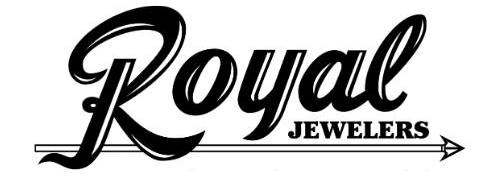How to Find The Perfect Diamond
Know what you want to spend.
You will be confronted with a dizzying array of choices when it comes to engagement rings. Have a price range in mind? Going in with fairly specific parameters will help your jeweler find the right diamond to fit your budget.
What kind of jewelry does she already wear?
Is she more classic or modern? Feminine or sophisticated? Does she wear more silver or gold? Do her pieces tend to be more delicate or chunky? Simple or ornate? Have these preferences in mind when you set out to shop. If you buy something similar to what she already likes, you can’t go wrong.
Know her ring size.
If she wears rings, borrow one she already owns. Trace the inner circle on a piece of paper, or press the ring into a bar of soap for an impression. You can also slide it down one of your own fingers and draw a line where it stops. A jeweler can use these measurements to identify her approximate ring size.
Are her preferences hard to pin down?
Consider buying an unset diamond. If you choose the diamond first and have the setting made later, you can include her in selecting the style and final details of the ring (always a good idea) and avoid the awkwardness of choosing a ring that’s more to your taste than hers.
Know what diamond shape suits her.
If she hasn’t made it easy for you by already voicing an opinion on the subject (or admiring someone else’s engagement ring), here are a few things to keep in mind when considering shape:
– She will be wearing this ring 24/7 every day of your married life. It will need to go with everything from jeans to evening wear. If you’re uncertain about her shape preference, it’s sensible to stick to the classics. They became classics because they appeal to most people most of the time.
– Shapes with fewer facets, such as emerald or square, require higher clarity. The fewer the facets, the more visible any inclusions will be.
– Certain shapes pair more successfully with other gems in multi-stone rings. Round, Oval and Marquise all work well. Pear and Heart shape are more challenging.
– Taste in shape is often reflected in other tastes a woman has. If she prefers clean, modern lines in furniture, for example, it’s likely she’ll react well to the same aesthetic in Emerald or Square shapes. If she tends towards the traditional, a round shape rarely misses. More bohemian types tend to favor more unusual shapes, like Trillian or Marquise.

What Setting Makes Sense?
While there are an unending variety of patterns, details and metal choices, there are four basic types you are likely to encounter:

Solitaire – A single stone. Still the most popular choice in engagement rings. The head secures the diamond. Prongs allow the diamond to catch the most light. A four-prong-setting shows more of the diamond, but a six-prong setting is often more secure.

Sidestone – Diamonds or other gemstones, flank the main stone for additional sparkle or color. Popular sidestone settings include ‘channel’, which protects stones by keeping them flush, and ‘bar-channel’, which allows more light to enter the sidestones.

Three Stone – One diamond for the past, one for the present, and one for the future. Typically, the center diamond is larger than the two side stones.
Halo – The main stone is surrounded by tiny diamonds to add sparkle and the illusion of greater size.
As to actual setting design, consider her lifestyle, and how well a certain setting will fit into it. If she’s more active or outdoorsy, look for lower profile, less ornate, more sturdy choices, which are less likely to get knocked or caught on things. If she’s more of a glamour girl, look for statement
Understand the 4Cs of Diamond Quality
This basic knowledge will not only unlock the mystery of a diamond’s quality, it will help you understand a diamond’s value and price.
 Diamond Color In most diamonds, the term actually refers to the absence of color. The less color in the stone, the more desirable and valuable it is. Some of these differences are not visible to the naked eye, but directly impact the overall quality and price of the stone.
Diamond Color In most diamonds, the term actually refers to the absence of color. The less color in the stone, the more desirable and valuable it is. Some of these differences are not visible to the naked eye, but directly impact the overall quality and price of the stone.
Diamond Clarity measures the amount, size and placement of internal ‘inclusions,’ and external ‘blemishes.’ Grades run from ‘Flawless,’ with virtually no imperfections, to ‘Included,’ which contain a significant number of imperfections.
Diamond Cut does not refer to a diamond’s shape, but to the proportion and arrangement of its facets and the quality of workmanship. The amount of brilliance, sparkle and fire in a diamond is determined by cut. Grades range from ‘Excellent’ to ‘Poor.’
Diamond Carat refers to a diamond’s weight. Generally speaking, the higher the carat weight, the more expensive the stone. Two diamonds of equal carat weight, however, can have very different quality and price when the other three Cs are considered.
No matter how beautiful a diamond may look you simply cannot see its true quality. The 4Cs of diamond quality will provide you with the information you need to know the diamond’s actual quality.[/vc_column_text][vc_column_text css_animation=”left-to-right”]
Understand the 4Cs of Diamond Quality
This basic knowledge will not only unlock the mystery of a diamond’s quality, it will help you understand a diamond’s value and price.
Diamond Color In most diamonds, the term actually refers to the absence of color. The less color in the stone, the more desirable and valuable it is. Some of these differences are not visible to the naked eye, but directly impact the overall quality and price of the stone.
Diamond Clarity measures the amount, size and placement of internal ‘inclusions,’ and external ‘blemishes.’ Grades run from ‘Flawless,’ with virtually no imperfections, to ‘Included,’ which contain a significant number of imperfections.
Diamond Cut does not refer to a diamond’s shape, but to the proportion and arrangement of its facets and the quality of workmanship. The amount of brilliance, sparkle and fire in a diamond is determined by cut. Grades range from ‘Excellent’ to ‘Poor.’
Diamond Carat refers to a diamond’s weight. Generally speaking, the higher the carat weight, the more expensive the stone. Two diamonds of equal carat weight, however, can have very different quality and price when the other three Cs are considered.
No matter how beautiful a diamond may look you simply cannot see its true quality. The 4Cs of diamond quality will provide you with the information you need to know the diamond’s actual quality.



